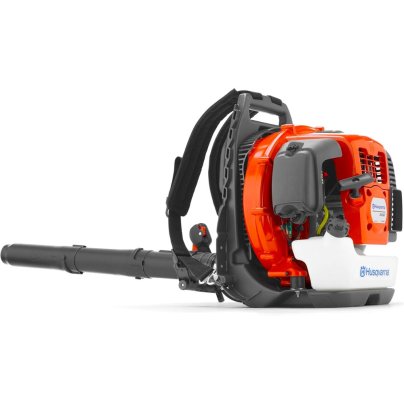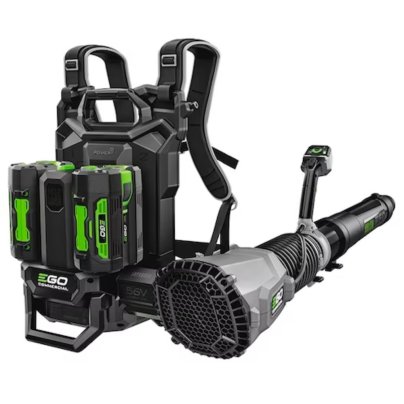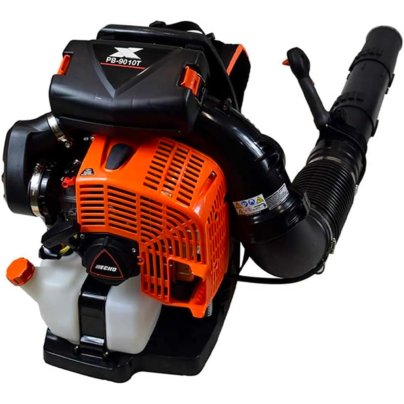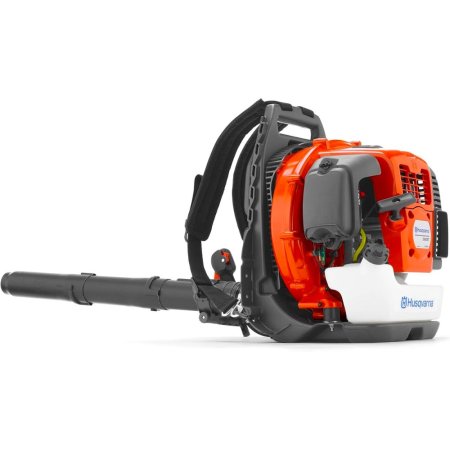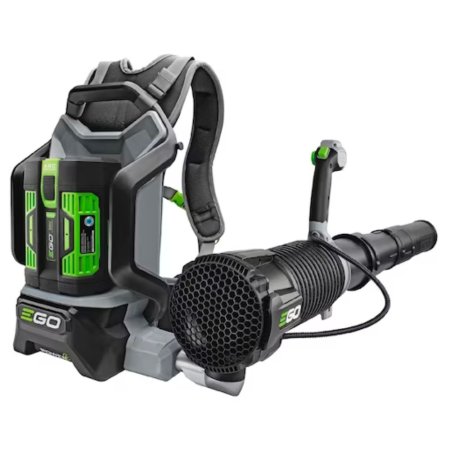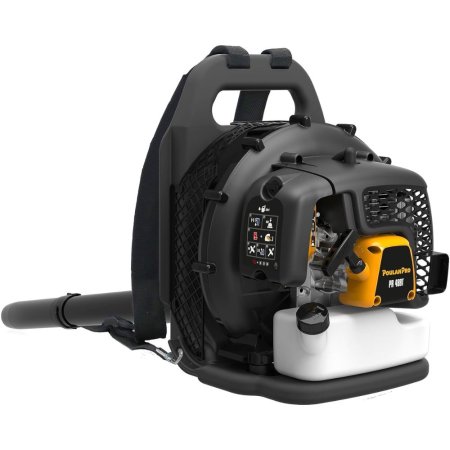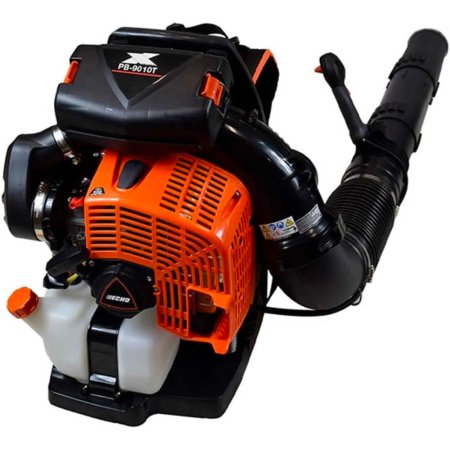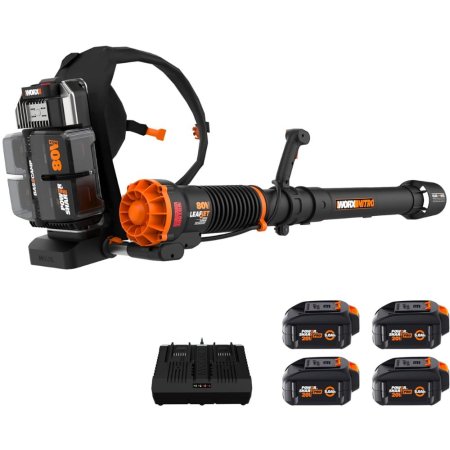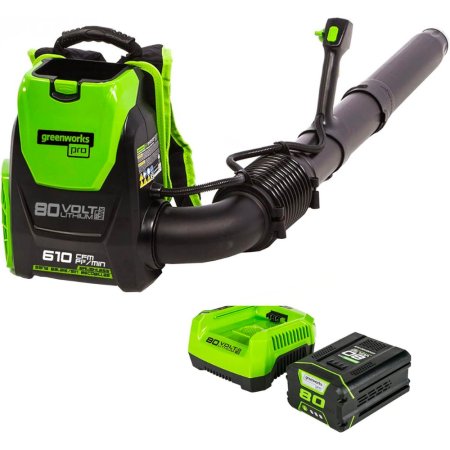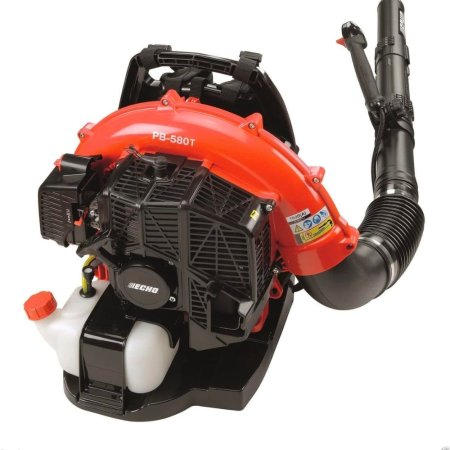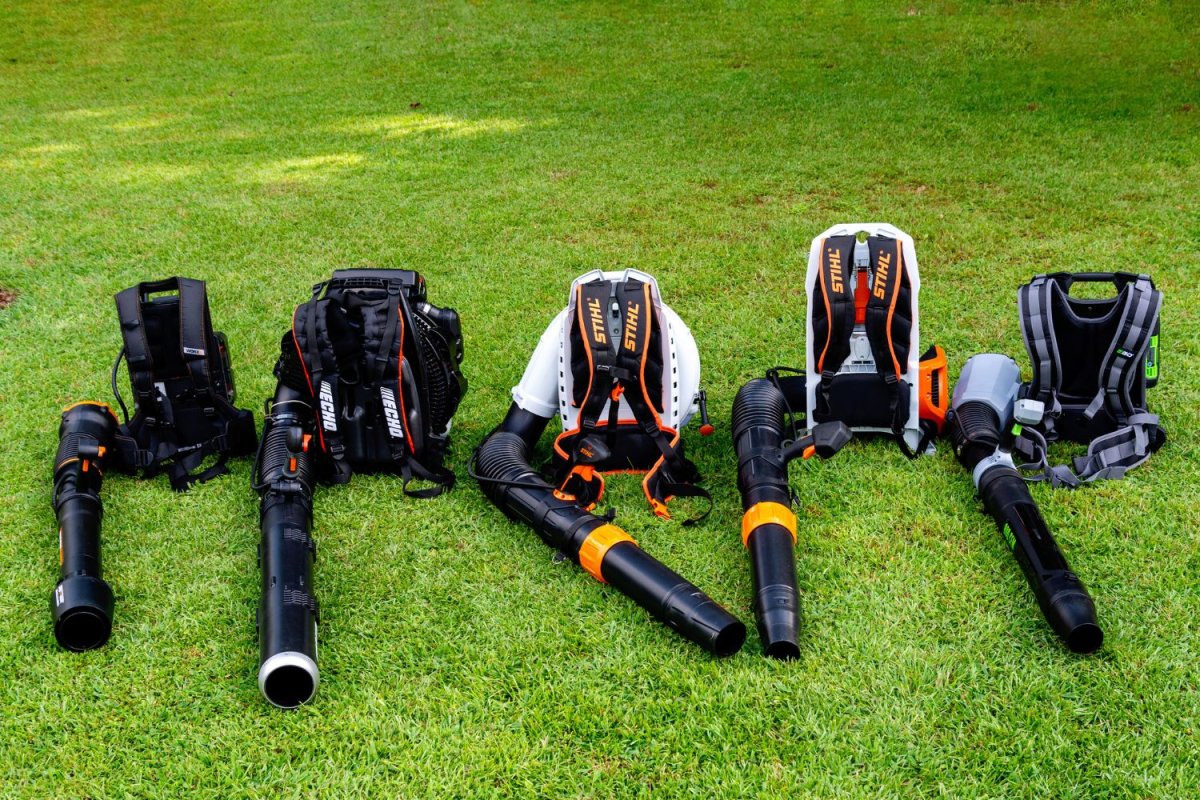
We may earn revenue from the products available on this page and participate in affiliate programs. Learn More ›
With a backpack leaf blower, yard cleanup is a snap. Leaf blowers make quick work of removing fallen leaves, grass clippings, dirt, and other debris from a property. Leaf blowers with adapter pipes can even clean rain gutters. A leaf blower can help speed up many projects to save time on yard work. With so many models on the market, deciding on which one to buy can be a challenge. To help, we tested the best backpack leaf blowers in several different categories.
Whether your yard is large or small, or whether you prioritize lower emissions, higher air velocity, or the least amount of noise, there’s probably a leaf blower that fits the bill for those needs. Brad Saunders, president of Heroes Lawn Care, a lawn care services company that services areas throughout the U.S., says first and foremost, shoppers will want to think about the amount of power and airflow they’ll need: “If you’re dealing with a lot of leaves or heavier debris, you’ll want something with a higher cubic feet per minute (CFM) to move those large piles efficiently and a good mile per hour (mph) to really blow things away.” Then take power source, weight, ergonomics, and sound level into account. And finally, think about the bells and whistles. “Some blowers come with attachments for vacuuming or mulching,” he says. “Variable-speed settings are also a nice touch, allowing you to adjust the power depending on whether you’re clearing a lawn or just tidying up a patio.”
Our favorite in testing was the Husqvarna 360BT Gas Backpack Leaf Blower for its outstanding performance and value. Plus, its engine design reduces exhaust emissions by up to 60 percent and also increases fuel efficiency by up to 20 percent. The list below represents extensive research into more of the best backpack leaf blowers on the market and our reviews based on our hands-on tests.
- BEST OVERALL GAS: Husqvarna 360BT Gas Backpack Leaf Blower
↓ Jump to Review - BEST OVERALL BATTERY: Ego Power+ LBPX8004-2 Commercial Backpack Blower
↓ Jump to Review - BEST BANG FOR THE BUCK: Poulan Pro PR48BT Gas-Powered Backpack Leaf Blower
↓ Jump to Review - RUNNER-UP: Echo PB-9010T Backpack Leaf Blower
↓ Jump to Review - BEST FOR HOME USE: Worx Nitro 80V Cordless Backpack Blower
↓ Jump to Review - BEST LIGHTWEIGHT BATTERY: Greenworks 80V 610 CFM Cordless Backpack Blower
↓ Jump to Review - BEST LIGHTWEIGHT GAS: Ryobi 175 MPH 760 CFM 38cc Gas Backpack Leaf Blower
↓ Jump to Review - BEST FOR LARGE YARDS: Echo PB-580T Backpack Leaf Blower
↓ Jump to Review
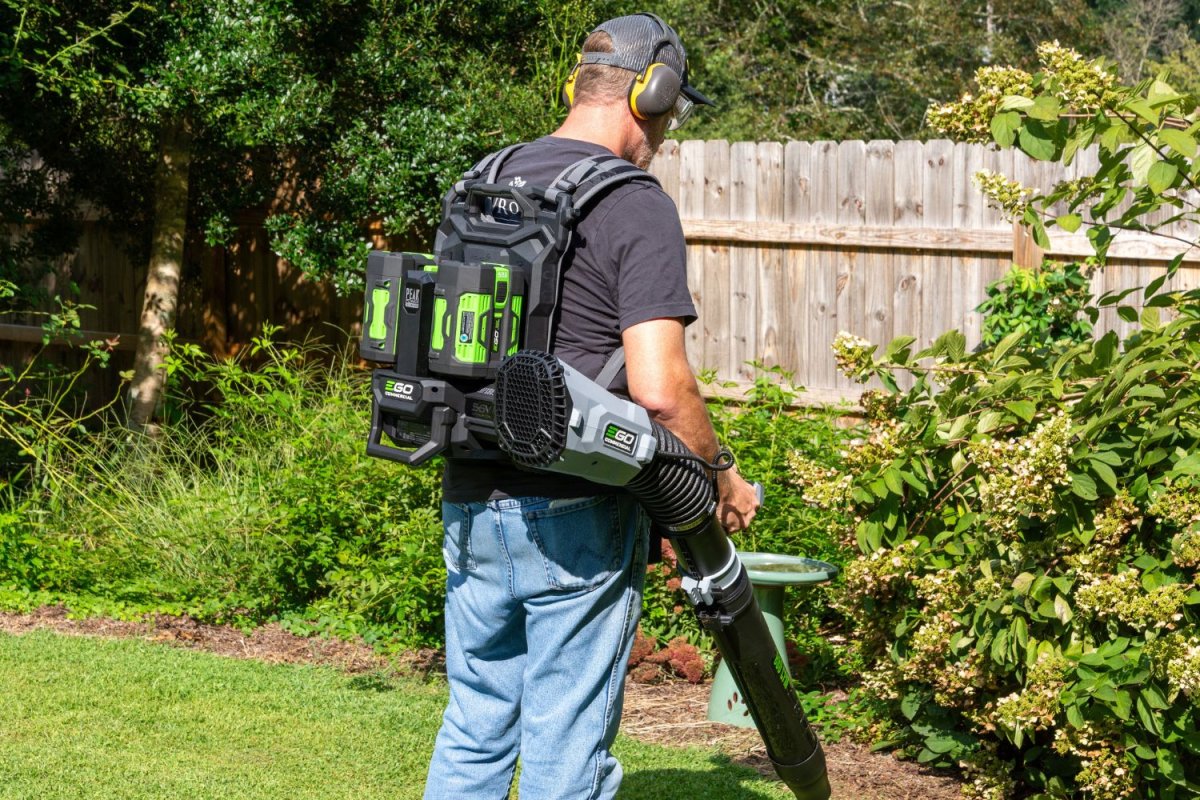
Before You Buy a Backpack Leaf Blower
Before buying a backpack leaf blower, it’s smart to check out regulations that might be in place with the local or state government or in a homeowners association. Noise is a factor that is a growing limitation to the use of leaf blowers. In many areas, regulations do not allow the use of loud equipment in neighborhoods during certain times of the day or week. Be sure that it’s OK to operate a leaf blower, which typically produces sounds between 65 and 100 decibels (dB), at the time of day and day of the week when you typically do yard work. If not, you will need to decide between raking and working at a different time.
The other big concern is the increasingly regulated use of 2-cycle engines. Even the cleanest gas lawn equipment engines that comply with California Air Resources Board (CARB) regulations pollute significantly more than the combined power plant emissions produced when charging batteries. Some states and cities have declared a moratorium on gas-powered lawn equipment. If the window on use of fossil fuels in your area is closing soon, it might make the most financial sense to go electric now rather than buying gas equipment only to replace it in a year or two.
Finally, be sure to consider the potential health side effects of using a backpack leaf blower. In a commercial setting, anyone operating a leaf blower is expected to wear hearing and eye protection. In some conditions, a dust mask may also be required. Private users are strongly advised to do the same. Also, because hearing is impaired by blower noise, it is smart to wear high-visibility clothing and walk with oncoming traffic in front of you whenever operating a leaf blower in the street.
| Testing Stats | |
| Products tested | 10 |
| Time spent testing | 10 hours |
| Tests performed | 4 to 5 |
| Price range | $290 to $700 |
Our Top Picks
We tested the industry’s best backpack blowers in our own backyard test course. Whether you maintain a large or small property, and whether you need more power or less noise, you might find just the right fit on this list of some of the best backpack leaf blowers on the market.
Best Overall Gas
Husqvarna 360BT Gas Backpack Leaf Blower
Product Specs
- Power source: 65-cubic-centimeter (cc) 2-cycle engine
- Airflow: 890 CFM, 232 mph
- Weight: 23.2 pounds
Our Ratings: Ease of Use 5/5;Comfort 4.5/5; Performance 5/5; Noise 3.5/5; Value 5/5
What We Like
- Professional-quality top air movement but average noise levels
- Low-profile suspension system with dampeners to reduce vibrations
- Large fuel tank extends runtime without need to refill
- Reduced emissions compared to other gas blowers
- Good fuel efficiency
What We Don’t Like
- Heavier than other models, though operation was comfortable
- Bulky profile is not as easy to store away
The Husqvarna 360BT gas-powered backpack leaf blower is a good all-around pick for large or small landscapes at a midrange price. The 65cc 2-cycle X-Torq engine pushes up to 890 CFM of air at 232 mph for general landscape cleanup. This machine weighs 23.2 pounds and comes equipped with a 74.4-ounce (0.58-gallon) fuel tank. Its engine noise level was about average compared to the others we tested, and it was easy to start and comfortable to carry. This blower truly excelled in air movement, outperforming all the others we tested on a price-to-performance comparison.
Although this is a gas model, Husqvarna’s X-Torq engine design reduces exhaust emissions by up to 60 percent and increases fuel efficiency by up to 20 percent. Dampeners between the engine and chassis reduce vibrations. The padded harness and hip belt are shaped to fit the contours of the operator for more comfortable operation. The offset handle makes the blow force easier to control, preventing arm strain and fatigue. The variable-speed throttle with cruise control can be set for easier handling.
Get the Husqvarna backpack leaf blower at Amazon, Lowe’s, or Northern Tool + Equipment.
Best Overall Battery
Ego Power+ LBPX8004-2 Commercial Backpack Blower
Product Specs
- Power source: Two 56-volt (V) 6-amp-hour (Ah) batteries
- Airflow: 800 CFM, 190 mph
- Weight: 29 pounds
Our Ratings: Ease of Use 4.3/5;Comfort 5/5; Performance 4.3/5; Noise 5/5; Value 4.5/5
What We Like
- Most powerful battery-powered backpack leaf blower we tested
- Well-padded harness system includes sternum strap and hip belt
- Excellent runtime per charge: 120 minutes on low; 25 to 30 minutes on high
- IPX5-rated weather-resistant
What We Don’t Like
- More expensive and less powerful than commercial gas-powered models
- More than 2 pounds heavier than the heaviest gas-powered leaf blower we tested
Lots of folks want to cut back their reliance on gas equipment, but cordless leaf blowers are often short on power and runtime. The Ego Power+ commercial backpack blower has risen to the challenge. Powered by two 56V 6 Ah rechargeable batteries, the 1,900-watt brushless motor generates power equivalent to a 60cc gas engine. It pushes up to 800 CFM of air at speeds up to 190 mph. And unlike the competition, it runs a long time per charge: 25 minutes on the highest power setting and up to 120 minutes on low.
The first thing we noticed about the Ego Power+ LBPX8004-2 was its weight. At 29 pounds with the batteries installed, it was about 2 pounds heavier than the heaviest 2-cycle leaf blower we tested. Thankfully, it also came equipped with an extremely well-padded adjustable harness system that included both a hip belt and sternum strap to lighten the load. Once we strapped in, the weight wasn’t bad at all.
As far as actual blowing performance goes, this was the strongest battery-powered leaf blower we’ve tested. We used it to clear fallen leaves off 5,000 square feet of lawn in less than 20 minutes and blew a gallon-size pile of damp sand off the driveway in 41 seconds. It was right up there with the Stihl BGA 300 backpack leaf blower at 26 newtons of blow force, but the Stihl weighed even more (38 pounds) and had a less convenient battery charging system. Combined with its high cost, higher weight, and battery limitations, the Stihl didn’t make our list of top picks.
The Ego Power+ commercial blower came with a dual charger that recharged both batteries in just 90 minutes. And the batteries are compatible with all Ego Power+ cordless tools. For residential as well as medium-duty commercial jobs, this could be a really good pick.
Get the Ego Power+ backpack leaf blower at Lowe’s, Ace Hardware, or Amazon (tool only).
Best Bang For The Buck
Poulan Pro PR48BT
Product Specs
- Power source: 48cc 2-stroke engine
- Airflow: 475 CFM, 200 mph
- Weight: 22 pounds
Our Ratings: Ease of Use 4/5;Comfort 5/5; Performance 3.5/5; Noise 3/5; Value 4/5
What We Like
- Lighter-than-average gas blower with comfortable suspension system
- Budget-friendly price point for a reliable tool
- Fuel efficient: lower operating cost and longer runtime per fill-up
- Great choice for dry leaves, grass clippings, and other lightweight debris
What We Don’t Like
- Only moderate air volume; less effective on heavy, wet debris
- Sticky throttle trigger doesn’t accelerate smoothly
The Poulan Pro PR48BT was a strong performer at an extremely competitive price point. At the lowest overall price, it took sixth place in our price-to-performance comparison. Its 48cc 2-stroke engine pushes 475 CFM at 200 mph. Weighing just 22 pounds, this model was lighter than its gas-powered competition, which averaged more than 23 pounds. The PR48BT comes with padded, adjustable shoulder straps and a heavy-duty frame. The variable-speed throttle has a cruise-control feature to reduce operator fatigue.
Poulan Pro tools are generally known for fair quality at a budget price, and in our tests, this blower equals or outperforms that reputation. It started easily, ran smoothly, and was comfortable to carry. The airflow was adequate for dry or damp leaves and grass clippings but not great for heavily matted or wet, heavy debris. Also, the engine runs noticeably louder than the other blowers we tested, so be sure to wear hearing protection during operation.
Get the Poulan Pro backpack leaf blower at Amazon or Tractor Supply Co.
Runner-up
Echo PB-9010T Backpack Leaf Blower
Product Specs
- Power source: 79.9cc 2-cycle engine
- Airflow: 1,110 CFM; 220 mph
- Weight: 26.7 pounds
Our Ratings: Ease of Use 4/5;Comfort 3/5; Performance 5/5; Noise 4/5; Value 4/5
What We Like
- Most powerful backpack blower with 48 newtons of blow force
- 2-stage air-filtration system extends engine life
- Large 83.8-ounce fuel tank ideal for extended use
- Deep padded shoulder straps and vented back pad improve user comfort
What We Don’t Like
- Small opening on the fuel tank makes it harder to fill without spilling
- Heaviest gas-powered backpack blower we tested
- Has no hip belt or sternum strap to reduce user fatigue
A top performer among gas-powered commercial models, the Echo PB-9010T commercial backpack blower offers the most blow force and longest running time of all the machines in our test group. Its powerful and efficient 79.9cc 2-cycle engine complies with CARB emission standards while driving an intense blow force of 1,110 CFM at 220 mph. And its 83.8-ounce (0.65-gallon) fuel tank virtually eliminates stops for refueling on all but the very largest properties.
In our tests, the Echo PB-9010T took first place in both of the timed tasks, rounding up 5,000 square feet of leaves in just 12 minutes and removing a gallon-size pile of damp sand in just 14 seconds. The noise level was a few decibels higher than the Husqvarna and Stihl blowers in the test group. It also weighed a couple of pounds more.
The harness system was fine but came with no hip belt or shoulder straps to reduce the load on the user’s shoulders, although the shoulder straps were very nicely padded. When we brought it along on an all-day landscape cleanup project, the giant fuel tank held enough mixed gas to disperse clumped grass clippings and clear pavement the entire day without running out. This model is an excellent option for those who prioritize production above all else.
Get the Echo PB-9010T backpack leaf blower at Amazon or The Home Depot.
Best For Home Use
Worx Nitro 80V Cordless Backpack Blower
Product Specs
- Power source: Four 20V 4 Ah batteries
- Airflow: 800 CFM, 150 mph
- Weight: 23.6 pounds
Our Ratings: Ease of Use 4.3/5;Comfort 4/5; Performance 4.3/5; Noise 4/5; Value 4/5
What We Like
- Pushes a lot of air; efficiently cleans up dry leaves, grass clippings
- Offers adequate runtime for properties of up to a half acre
- BaseCamp battery pack also powers the Worx Nitro 80-volt cordless lawn mower
What We Don’t Like
- Lower air speed is less effective for moving heavy, wet debris
- Operates at a higher noise level than other battery-powered blowers
Even on small to midsize properties up to a half acre, a backpack blower can be a helpful labor saver. The Worx Nitro backpack blower, powered by the BaseCamp battery pack, uses four 20-volt 4Ah batteries to generate airflow up to 800 CFM at 150 mph with 20 minutes of runtime on the highest setting, or 230 minutes on low. In our timed tests, it cleared fallen leaves off 5,000 square feet of lawn in 25 minutes and dispersed a 1-gallon pile of sand off the driveway in 67 seconds.
Although it was not the lightest, most powerful, nor least expensive battery-powered backpack blower we tested, the Nitro backpack blower delivers enough power and runtime for smaller yards. It rated near the top in operator comfort. The harness system was well padded and extremely supportive, and the motor and battery pack fit closely to the back, which made it easier to maneuver compared to big bulky gas models.
We also appreciated that the BaseCamp power pack uses the same interchangeable 20-volt PowerShare batteries found throughout the Worx ecosystem, and that it is compatible with the Nitro Cordless Lawn Mower. For a balance of comfortable operation, efficient power sharing, compact storage, quality, and performance for smaller properties, the Worx backpack blower makes a great option.
Get the Worx backpack leaf blower at Amazon, Walmart, or Target.
Best Lightweight Battery
Greenworks 80V 610 CFM Cordless Backpack Blower
Product Specs
- Power source: 80V rechargeable battery
- Airflow: 610 CFM, 145 mph
- Weight: 14.64 pounds
Our Ratings: Ease of Use 4/5;Comfort 5/5; Performance 3.5/5; Noise 4/5; Value 4/5
What We Like
- Produces good airflow, comparable to some lightweight gas-powered models
- Most lightweight model among our test group
- Easy and comfortable to carry
- Low-profile design; can maneuver and store easily
What We Don’t Like
- Battery provided shortest runtime per charge among the battery models tested
- Airflow is not adequate for moving heavy, wet debris
The Greenworks 80V cordless backpack leaf blower is a powerful, clean-operating leaf blower that makes an ideal choice for smaller landscapes. It moves up to 610 CFM of air at 145 mph and is powered by an 80V lithium-ion rechargeable battery. Weighing just 14.64 pounds, it was the lightest-weight model we tested.
The Greenworks leaf blower showed similar capability to that of the smaller gas-powered models, which is to say it easily handled dry and damp material but struggled with the heaviest matted debris. Operating on the high power setting, it ran for about 20 minutes, after which it took 45 minutes to recharge the battery.
The brushless motor delivers gas-equivalent performance, with up to 1.5 hours of runtime per charge on the low power setting. A variable-speed trigger and turbo button deliver on-demand power. Cruise control reduces operator fatigue. Adjustable padded shoulder straps provide added comfort. The kit includes one 2.5 Ah battery and charger.
Get the Greenworks backpack leaf blower at Amazon, Lowe’s, or Walmart.
Best Lightweight Gas
Ryobi 175 MPH 760 CFM 38cc Gas Backpack Leaf Blower
Product Specs
- Power source: 38cc 2-cycle engine
- Airflow: 760 CFM, 175 mph
- Weight: 20.2 pounds
Our Ratings: Ease of Use 3.8/5;Comfort 5/5; Performance 4.5/5; Noise 3.5/5; Value 4.8/5
What We Like
- Second-best value among all tested models
- Lightweight backpack blower
- Adjustable, deeply padded shoulder straps
- Small 2-cycle engine with impressive fuel economy; works harder using less gas
What We Don’t Like
- Rigid blower tube limits maneuverability
- Bulky engine is more awkward in tight spaces and more difficult to store
Ryobi’s inexpensive leaf blower with its little 38cc 2-cycle engine can’t really generate as much airflow as our “Best Overall” pick, can it? In our tests, it nearly did. We were impressed by its ability to break up matted wet leaves, grass clippings, and even ant mounds, then blow them away without hesitation. The 760 CFM 175 mph ratings seem to be almost surprisingly accurate.
This level of performance comes at a price, however. The unique rigid blower tube configuration did not allow the full range of movement that other backpack blowers offer. We could perform a sweeping motion but could not rotate the control handle or easily direct the nozzle hard to the right. Still, the impressive blower force makes this a good tool for bigger jobs in open spaces, and it’s offered at a very affordable price.
Get the Ryobi backpack leaf blower at The Home Depot.
Best For Large Yards
Echo PB-580T Backpack Leaf Blower
Product Specs
- Power source: 58.2cc 2-cycle engine
- Airflow: 517 CFM, 216 mph
- Weight: 22.7 pounds
Our Ratings: Ease of Use 4.5/5;Comfort 5/5; Performance 5/5; Noise 4.5/5; Value 4/5
What We Like
- Started easily every time, on the second pull after choking
- Comfortable shoulder straps; deep padding and adjustable suspension system
- Vented back pad eliminates heat buildup
- Less vibration and noise (70dB) than similarly equipped gas leaf blowers
What We Don’t Like
- Priced a bit higher than other models with comparable airflow ratings
With its 58.2cc 2-cycle engine, this midsize blower offers a bit more power than the more budget-friendly models, and it weighs in at an easy-to-carry 22.7 pounds. But the weight is less noticeable here than on the others because of a well-balanced suspension system and generously padded, contoured shoulder straps. It moves up to 517 CFM per minute at up to 216 mph. It’s not the highest airflow in its class, but it’s still capable of moving heavy, wet debris into piles.
This Echo backpack blower is a good choice for those with large yards, where cheaper models may suffer over time from consistent extended use. The controls on the handle and moving parts on the blower tube operate smoothly and feel much more durable than those on the competition. The only inconvenience was that this blower did not include a blower tool—a combination spark plug remover and screwdriver/carburetor adjustment tool—which most others include.
Get the Echo PB-580T backpack leaf blower at Amazon or The Home Depot.
Jump to Our Top Picks
How We Tested the Best Backpack Leaf Blowers
Backpack blowers generally offer far greater airflow and dexterity than handheld blowers so users can clean up big jobs quickly and with less fatigue. We focused our backpack blower field tests on ease of operation, user comfort, and airflow.
We assembled and fueled or charged up the blowers according to the manufacturers’ instructions and then carefully adjusted the handle controls, suspension systems, and shoulder straps to fit comfortably. Then, one by one, we started the blowers and used them to blow fallen leaves on pavement, mowed lawn grass, and rough field grass, followed by old built-up debris in a wooded area. Finally, we used them to clear away wet sand and puddles from uneven pavement. Each of the blowers in this guide successfully completed the full range of testing.
What to Consider When Choosing a Backpack Leaf Blower
There are several key considerations to bear in mind when shopping for a new leaf blower. It needs to be powerful enough to clear debris and have sufficient power (in the battery or in the fuel tank) to do the entire yard. In this section, we’ll take a close look at these and other important shopping considerations.
Yard Size
Properties larger than half an acre with leafy trees, lots of grass, outbuildings, and other areas that require detailed cleaning benefit from maximum runtime and airflow from a gas-powered blower. A powerful blower with a long runtime blows debris farther and faster than a less powerful model. They’re also more efficient because you don’t have to stop your work to refuel or change the blower’s batteries.
A lightweight battery-powered blower is suitable for a smaller property or if only blowing leaves off the sidewalk, patio, or driveway.
Power Source and Runtime
Battery power is measured in volts. Battery-powered blowers usually have a limited runtime of about 1.5 hours maximum for light-duty applications. Heavy-duty blowing decreases the runtime to as little as 10 to 15 minutes.
Gas-powered blowers are limited only by the size of their fuel tanks. Engine size is measured in cubic centimeters. Most gas blowers’ tanks hold enough fuel to operate at high power for 1.5 to 3 hours.
2-Cycle vs. 4-Cycle Engine
Gasoline-powered blowers have either a 2-cycle or a 4-cycle engine. A 2-cycle engine needs one revolution of the crankshaft to produce a power stroke, while a 4-cycle engine needs two revolutions of the crankshaft to produce the power stroke. A 2-cycle engine produces more power than the same size 4-cycle engine.
Blowers with 2-cycle engines require a fuel mixture of gas and oil that powers and lubricates the engine at the same time, while 4-cycle engines run on gasoline and have a separate oil reservoir to lubricate the engine. On average, efficient 2-cycle engines produce more power than 4-cycle engines of the same size, but clean-running 4-cycle engines produce lower emissions.
Saunders says that 2-cycle engines are the “go-to for people who need something lightweight and powerful.” He adds, “They’re great because they run at higher revolutions per minute, which means they can handle tasks like trimming and blowing with a bit more oomph.” However, 4-cycle engines have their own advantages: “They tend to have more torque at lower speeds, which can be really helpful if you’re dealing with heavier work. Another big plus is that they’re usually easier to start and run quieter, which is great if you’re working in a residential area or just don’t want to deal with a lot of noise.”
Air Volume and Speed
The two best measurements of a leaf blower’s performance are the air volume, measured in cubic feet per minute, and the airspeed, measured in miles per hour. Air volume is how much air moves through the machine, while airspeed measures how fast it is moving. The better measurement of leaf-moving ability is CFM.
Manufacturers indicate the average maximum CFM and mph values on product labels, but the speed at which blowers truly operate depends on the user. Users control backpack blowers’ power settings via a trigger or a lever. The machine needs to run on full power to reach the maximum CFM and mph ratings indicated on the product’s package. To clean up hard surfaces like driveways and patios, 400 CFM blowers are sufficient. Use a 500 to 700 CFM blower for larger properties with significant lawn and leaf areas.
Weight
Battery-operated backpack blowers weigh as little as 15 pounds, while their gasoline-powered counterparts average about 10 pounds heavier. Weight certainly affects comfort, especially on large properties where leaf blowing may take an hour or more.
A leaf blower’s weight generally coincides with its power, so it’s not always prudent to purchase the lightest model. Instead, choose the blower with an ideal combination of weight and high power.
Comfort Features
Comfort minimizes user fatigue and reduces the chance of injury. Features that affect user comfort include the leaf blower’s size, harness system, hand controls, and tube.
The user’s body size dictates which overall machine dimensions are appropriate. A tall and heavy user can operate any size blower, but an operator with a smaller frame would more likely be most comfortable using a compact blower.
The leaf blower’s harness system can feature an adjustable waist strap and adjustable shoulder straps, all with plenty of padding, plus a sternum strap for added stability and balance. Tubes that flex and rotate comfortably at the user’s elbow are usually more comfortable. The hand controls that are sensitive enough to work smoothly, single-handedly, are easier to use, too.
Noise
Backpack blowers average 95 to 105dB, measured at the user’s ear level. To avoid hearing loss, it is important to wear earplugs or over-ear protection while operating a leaf blower.
Some municipalities have noise ordinances that dictate how loud machinery can be, so be sure to check local laws before purchasing a new blower. There are low-noise backpack leaf blowers on the market that average between 58 and 70dB and are powerful enough to get the job done efficiently.
Accessories
Several safety accessories help minimize the risks of injury while operating a blower. In addition to hearing protection, leaf-blower manufacturers and the Occupational Safety and Health Administration recommend the use of safety glasses to keep lawn debris out of the eyes. A high-visibility safety vest, hat, and gloves allow users working near streets and sidewalks to be seen by oncoming traffic.
Other helpful accessories include extra batteries for cordless electric blowers and a spark-plug wrench and fuel funnel for gasoline-powered blowers.
Types of Backpack Leaf Blowers
While there are many factors to consider when searching for the right backpack leaf blower, the main difference among the options is whether they are powered by gasoline or electricity. The power source affects the leaf blower’s weight, airspeed, runtime, and other factors.
Gas-Powered
Gas-powered blowers are the go-to choice for landscaping professionals because they offer high power and lots of runtime per tank of fuel. They efficiently clean up large properties without the user having to stop and refill the gas tank. Gas-powered blowers are ideal for yards of a half acre and larger, where battery-powered blowers run out of power. They’re also great for smaller properties with heavy leaf cover that require more consistent power for efficient cleanup.
Gas-powered blowers require both fuel and oil, which adds to their operating cost. They emit exhaust fumes and should only be used in well-ventilated outdoor spaces.
Battery-Powered
Battery-powered backpack blowers offer a clean-running, lightweight alternative to gas-powered blowers. They work especially well for smaller properties of less than half an acre and where leaf cover is lighter. Runtime varies significantly among models. Power settings also have a lot to do with how long a blower will run: On average, battery-powered blowers can run for as short as 10 minutes on high power to as long as 1.5 hours on low power.
The performance of most battery-powered backpack leaf blowers is similar to that of gas-powered blowers, but the battery-powered blowers run for a shorter length of time. Because it can take an hour or more to recharge a blower’s batteries, some owners buy additional batteries to avoid downtime.
The Advantages of Owning a Backpack Leaf Blower
To clean up leaves, grass clippings, dust, and other yard debris, it’s hard to beat the functionality of a backpack leaf blower. They help clean up leaves and grass in a fraction of the time it takes to rake, plus they move fine particles like dust and powdery snow with ease. They keep all outdoor areas clean and tidy, including lawns, landscape beds, driveways, porches, patios, and decks.
Backpack blowers are more powerful and versatile than handheld blowers. They easily remove matted, wet leaves from hard-to-reach areas like foundation plantings and fence corners. They can also be used to keep rain gutters clean.
- Backpack blowers are less fatiguing than handheld blowers because the weight of the blower is carried on the user’s back and hips, rather than on the user’s arms.
- They deliver plenty of air power for moving heavy debris.
- The added power of a backpack blower gets the work done much faster than either raking or using a handheld blower.
FAQs
If you’re still unsure about whether a backpack leaf blower is right for you, continue reading. Ahead you’ll find answers to commonly asked questions about using backpack leaf blowers.
To use a leaf blower, pile up debris such as fallen leaves, start by determining where the pile should be. Then walk to the distant edge of the area and use a low, steady sweeping motion to move the leaves toward the pile. Aiming the air tube across the top of the debris keeps it low to the ground. To dislodge matted, wet leaves, aim the tube low and force air beneath it.
Yes. The higher the combined CFM and mph ratings, the more effectively the blower moves wet leaves.
On average, backpack leaf blowers are more powerful than handheld blowers. They also have the advantage of reducing operator fatigue by transferring the weight of the machine to larger core muscles in the body.
Blowing power is a function of both air volume (CFM) and air speed (mph). Greater CFM affects a larger area and keeps material moving further. Faster mph moves bigger, heavier pieces of debris.
Why Trust Bob Vila
Bob Vila has been America’s Handyman since 1979. As the host of beloved and groundbreaking TV series including “This Old House” and “Bob Vila’s Home Again,” he popularized and became synonymous with “do-it-yourself” home improvement.
Over the course of his decades-long career, Bob Vila has helped millions of people build, renovate, repair, and live better each day—a tradition that continues today with expert yet accessible home advice. The Bob Vila team distills need-to-know information into project tutorials, maintenance guides, tool 101s, and more. These home and garden experts then thoroughly research, vet, and recommend products that support homeowners, renters, DIYers, and professionals in their to-do lists.
Meet the Tester
Mark Wolfe is a writer and product tester with a background in the nursery and landscaping industries. For more than 20 years he mowed, edged, planted, pruned, cultivated, irrigated, and renovated beautiful landscapes. Now he tests and writes reviews about the latest outdoor power equipment, hand tools, lawn-care products, and other outdoor-living goods.
